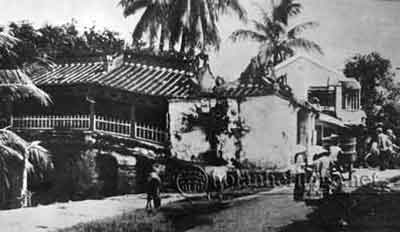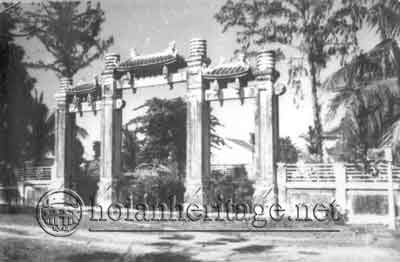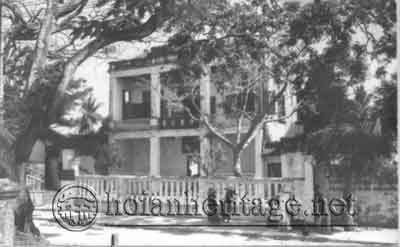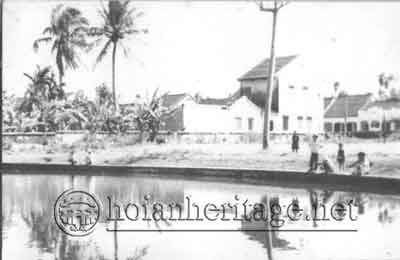Hoi An World Cultural Heritage Conservation Center
Promoting the value of revolutionary historical relics in Hoi An
Since the French colonialists, followed by the American imperialists, launched a war of aggression against our country, the army and people of Hoi An have promoted the tradition of patriotism, united with the spirit of the nation, and stood up to fight the revolution under the leadership of the Party until the day of liberation of the homeland and unification of the country.

Nguyen Duy Hieu statue in Hoi An - Photo: Quang Ngoc
On that long journey, continuously for nearly a hundred years, generations of cadres, soldiers and people of Hoi An, the predecessors fell, the successors stood up and raised high the flag of patriotism and revolution to "Determine to die for the fatherland, decide to live", turning sorrow into action to call on countless hearts to rise up and fight the enemy. Every inch of land, every branch of tree, every blade of grass on the land of Hoi An has been soaked with the blood, sweat and efforts of many generations of revolutionaries and compatriots who sacrificed their lives in the two resistance wars to defend the country.
Up to now, with the efforts of the entire political system, including the role and responsibility of the cultural sector, we have surveyed, inventoried, catalogued, managed, preserved and promoted the value of a total of 70 revolutionary historical relics distributed in all communes and wards in the city.
In terms of the type and content of the relic events, it can be seen that most of the relics are places that mark the heroic feats of arms of the army and people of Hoi An, associated with the achievements of the province's armed forces in Hoi An during the resistance wars. Many relics are places that mark important revolutionary events of the province and Hoi An. Among them are typical relics such as: Duc An house relic marks the birth of the Vietnam Revolutionary Youth Association in Hoi An in October 1927; Cay Thong Mot relic marks the establishment of the Quang Nam Provincial Party Committee on the evening of March 28, 1930; Huynh Du house relic marks the meeting of the Hoi An Uprising Committee on August 17, 1945, deciding the time of the General Uprising to seize power in Hoi An during the August Revolution in 1945; Thanh Nhat communal house relic marks the victory of the Dong Khoi movement in Cam Thanh that took place on the night of September 27, 1964... Many relics were bases, military bases, and shelters of revolutionary forces, of which the most typical are: Bay Mau Coconut Forest relic, Xom Chieu relic, Tra Que village relic, Mo Coi hamlet relic... The relics are places that record the crimes of the enemy, especially 3 prisons built by colonialists and imperialists in Hoi An, existing consecutively, including: Faifo Prison from the beginning of the 20th century to 1945, Thong Dang Prison from 1947 - 1959, Hoi An Prison from 1960 - 1975. These were 3 large-scale provincial prisons, in each prison, the enemy imprisoned thousands of cadres, soldiers, and patriotic compatriots in Quang Nam province and several other provinces; Among them, many comrades later became leaders of the country, senior officials of the Central Committee, generals of the Vietnam People's Army, outstanding leaders of Quang Nam - Da Nang and other provinces.
Regarding the current characteristics, due to the characteristics and nature of the relics, the destruction of war and some other reasons, most of the revolutionary historical relics in Hoi An are now only places to mark historical events. The remaining physical traces are quite modest. However, only the Hoi An Prison relic is still quite intact in terms of space and structure of the former prison items; it has been invested in and restored quite completely to date.
Regarding value and significance: There are 14 relics ranked as provincial relics, 01 relic is submitting a dossier for the Provincial People's Committee to consider and recognize in the coming time. Particularly, the prison system during the colonial and imperial periods has also been proposed to the provincial professional agency to prepare a dossier to propose to the competent authority to rank it at the national level. It can be said that this is a part of the heritage with important significance that constitutes the overall value of Hoi An's cultural heritage.

Identifying the important role of education and promoting the revolutionary tradition of the heroic homeland of Hoi An, right after the liberation day, Hoi An Party Committee has focused on emphasizing this work in the Congress documents. Implementing Directive No. 42-CT/TW dated March 24, 2015 of the Central Party Secretariat and Directive No. 02-CT/TU dated December 14, 2015 of the Quang Nam Provincial Party Committee on strengthening the Party's leadership in educating revolutionary ideals, ethics, and cultural lifestyle for the young generation in the period 2015 - 2030, up to now, the entire political system in the city has paid much attention, integrating and implementing many practical and quite exciting activities. In that common effort, the cultural sector has soon focused on implementing the work of investigating, surveying, and zoning off revolutionary relics in the field; collecting documents on historical events related to the relics; establishing management records; Building scientific dossiers for ranking at all levels. Investment in restoration and embellishment has also been gradually promoted. Most of the relics have now been erected with information steles and regularly maintained; many relics have been invested in spacious and beautiful campuses to serve the promotion work. Among them, the Cao Hong Lanh Memorial House has been established at the Duc An relic site for visitors since 2010; the revolutionary tradition exhibition room has been established at the Hoi An Museum; the restoration and embellishment project and the exhibition items at the Hoi An Prison relic site have been completed. Currently, there are 02 key projects, which are the restoration and embellishment of the Bay Mau Coconut Forest relic site and the One Pine Tree relic site, which have had policies and are promoting implementation procedures in the coming time.
Regarding the promotion work, from the beginning, the cultural sector has presided over and coordinated with sectors, organizations, and localities to develop reports and videos introducing relics for propaganda in schools and youth organizations. In recent years, many articles introducing relics and historical figures have been published in the Cultural Journal, Heritage Conservation Research Information Collection, and the weekly Heritage Conservation Radio Column. The Red Address Handbook for Youth in Hoi An published in 2019, upgraded in 2021, has been widely disseminated to commune/ward Youth Unions in the city to serve propaganda work and organize outdoor activities to the source of Youth Union organizations. The application of digitalization to propagate relics has also been initially deployed, such as: Introducing the Red Address Handbook for Youth in Hoi An online; implementing a "Digital Map" to locate relics and red addresses of the city on Google-Map; implementing an online exhibition of "Some red addresses of Hoi An's youth"; digitizing information of 24 relics in Vietnamese and English and attaching "QR Code Boards" at the relics.
In particular, from 2021 to present, Hoi An Prison relic has become a key tourist destination, attracting an increasing number of visitors with a total of 74 groups including 4,456 visitors, belonging to many different groups: students, youth unions, patriotic prisoners, veterans, officials - civil servants, ... inside and outside the city. Currently, the Center is promoting to invest in more exhibition items, equipment systems, building programs to organize sightseeing activities, promoting the value of relics more and more effectively.
In the coming time, with the attention of the political system in general, the cultural sector in particular, especially the role of the education sector and youth organizations of the city, the work of promoting the value of revolutionary historical relics among the young generation promises to achieve more and more results, contributing positively to the task of building and developing the culture and people of Hoi An.
Up to now, with the efforts of the entire political system, including the role and responsibility of the cultural sector, we have surveyed, inventoried, catalogued, managed, preserved and promoted the value of a total of 70 revolutionary historical relics distributed in all communes and wards in the city.
In terms of the type and content of the relic events, it can be seen that most of the relics are places that mark the heroic feats of arms of the army and people of Hoi An, associated with the achievements of the province's armed forces in Hoi An during the resistance wars. Many relics are places that mark important revolutionary events of the province and Hoi An. Among them are typical relics such as: Duc An house relic marks the birth of the Vietnam Revolutionary Youth Association in Hoi An in October 1927; Cay Thong Mot relic marks the establishment of the Quang Nam Provincial Party Committee on the evening of March 28, 1930; Huynh Du house relic marks the meeting of the Hoi An Uprising Committee on August 17, 1945, deciding the time of the General Uprising to seize power in Hoi An during the August Revolution in 1945; Thanh Nhat communal house relic marks the victory of the Dong Khoi movement in Cam Thanh that took place on the night of September 27, 1964... Many relics were bases, military bases, and shelters of revolutionary forces, of which the most typical are: Bay Mau Coconut Forest relic, Xom Chieu relic, Tra Que village relic, Mo Coi hamlet relic... The relics are places that record the crimes of the enemy, especially 3 prisons built by colonialists and imperialists in Hoi An, existing consecutively, including: Faifo Prison from the beginning of the 20th century to 1945, Thong Dang Prison from 1947 - 1959, Hoi An Prison from 1960 - 1975. These were 3 large-scale provincial prisons, in each prison, the enemy imprisoned thousands of cadres, soldiers, and patriotic compatriots in Quang Nam province and several other provinces; Among them, many comrades later became leaders of the country, senior officials of the Central Committee, generals of the Vietnam People's Army, outstanding leaders of Quang Nam - Da Nang and other provinces.
Regarding the current characteristics, due to the characteristics and nature of the relics, the destruction of war and some other reasons, most of the revolutionary historical relics in Hoi An are now only places to mark historical events. The remaining physical traces are quite modest. However, only the Hoi An Prison relic is still quite intact in terms of space and structure of the former prison items; it has been invested in and restored quite completely to date.
Regarding value and significance: There are 14 relics ranked as provincial relics, 01 relic is submitting a dossier for the Provincial People's Committee to consider and recognize in the coming time. Particularly, the prison system during the colonial and imperial periods has also been proposed to the provincial professional agency to prepare a dossier to propose to the competent authority to rank it at the national level. It can be said that this is a part of the heritage with important significance that constitutes the overall value of Hoi An's cultural heritage.

Hoi An Prison relic - Photo: Quang Ngoc
The system of revolutionary historical relics in Hoi An is vivid evidence of the long, arduous but glorious and proud struggle to gain independence, freedom and liberation of the homeland of the army and people of Hoi An; demonstrating the tradition of ardent patriotism, steadfast revolutionary will, heroic fighting spirit, burning desire for freedom, absolute trust in the leadership of the Party and Uncle Ho, belief that victory in just wars belongs to us; has a very vivid, intuitive and meaningful traditional educational value, thereby urging the will and determination of the next generation to overcome all difficulties and challenges towards building and protecting the increasingly beautiful homeland of Hoi An. Especially for the young generation, revolutionary historical relics also contribute to educating morality, good lifestyle, gratitude, building ambitions, aspirations, and the desire to contribute youth, enthusiasm and intelligence to the cause of building and protecting the Fatherland.Identifying the important role of education and promoting the revolutionary tradition of the heroic homeland of Hoi An, right after the liberation day, Hoi An Party Committee has focused on emphasizing this work in the Congress documents. Implementing Directive No. 42-CT/TW dated March 24, 2015 of the Central Party Secretariat and Directive No. 02-CT/TU dated December 14, 2015 of the Quang Nam Provincial Party Committee on strengthening the Party's leadership in educating revolutionary ideals, ethics, and cultural lifestyle for the young generation in the period 2015 - 2030, up to now, the entire political system in the city has paid much attention, integrating and implementing many practical and quite exciting activities. In that common effort, the cultural sector has soon focused on implementing the work of investigating, surveying, and zoning off revolutionary relics in the field; collecting documents on historical events related to the relics; establishing management records; Building scientific dossiers for ranking at all levels. Investment in restoration and embellishment has also been gradually promoted. Most of the relics have now been erected with information steles and regularly maintained; many relics have been invested in spacious and beautiful campuses to serve the promotion work. Among them, the Cao Hong Lanh Memorial House has been established at the Duc An relic site for visitors since 2010; the revolutionary tradition exhibition room has been established at the Hoi An Museum; the restoration and embellishment project and the exhibition items at the Hoi An Prison relic site have been completed. Currently, there are 02 key projects, which are the restoration and embellishment of the Bay Mau Coconut Forest relic site and the One Pine Tree relic site, which have had policies and are promoting implementation procedures in the coming time.
Regarding the promotion work, from the beginning, the cultural sector has presided over and coordinated with sectors, organizations, and localities to develop reports and videos introducing relics for propaganda in schools and youth organizations. In recent years, many articles introducing relics and historical figures have been published in the Cultural Journal, Heritage Conservation Research Information Collection, and the weekly Heritage Conservation Radio Column. The Red Address Handbook for Youth in Hoi An published in 2019, upgraded in 2021, has been widely disseminated to commune/ward Youth Unions in the city to serve propaganda work and organize outdoor activities to the source of Youth Union organizations. The application of digitalization to propagate relics has also been initially deployed, such as: Introducing the Red Address Handbook for Youth in Hoi An online; implementing a "Digital Map" to locate relics and red addresses of the city on Google-Map; implementing an online exhibition of "Some red addresses of Hoi An's youth"; digitizing information of 24 relics in Vietnamese and English and attaching "QR Code Boards" at the relics.
In particular, from 2021 to present, Hoi An Prison relic has become a key tourist destination, attracting an increasing number of visitors with a total of 74 groups including 4,456 visitors, belonging to many different groups: students, youth unions, patriotic prisoners, veterans, officials - civil servants, ... inside and outside the city. Currently, the Center is promoting to invest in more exhibition items, equipment systems, building programs to organize sightseeing activities, promoting the value of relics more and more effectively.
In the coming time, with the attention of the political system in general, the cultural sector in particular, especially the role of the education sector and youth organizations of the city, the work of promoting the value of revolutionary historical relics among the young generation promises to achieve more and more results, contributing positively to the task of building and developing the culture and people of Hoi An.
Author: Nguyễn Cường
Source: Hoi An Center for Cultural Heritage Management and Preservation:
Newer articles
Older articles










